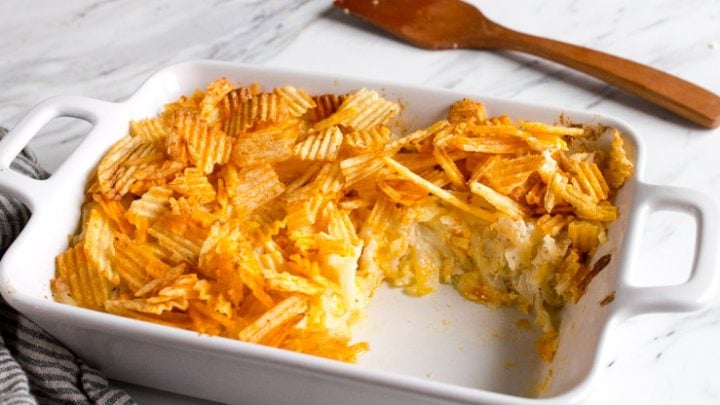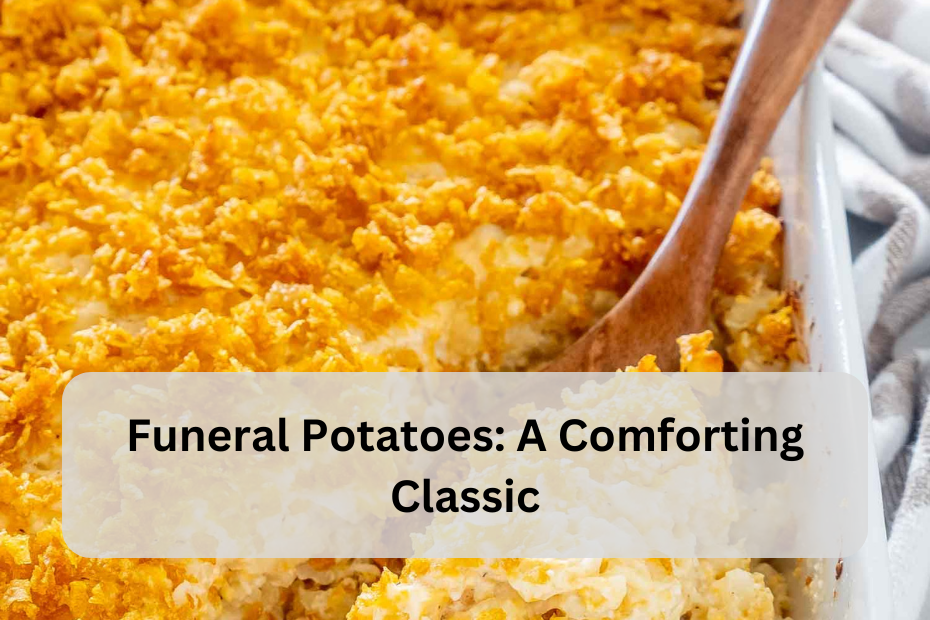Funeral potatoes, also known as cheesy potato casserole or hash brown casserole, is a beloved dish in many American households. Despite its somber name, funeral potatoes are a symbol of comfort, community, and nostalgia. This hearty dish is often served at gatherings, potlucks, and, as the name suggests, post-funeral meals, where comfort food is a source of solace. In this article, we will explore the origins of funeral potatoes, the basic recipe, variations, serving suggestions, and answer some frequently asked questions.
The Origins of Funeral Potatoes

The exact origins of funeral potatoes are difficult to pinpoint, but the dish is deeply rooted in American culinary traditions, particularly in the Midwest and among members of The Church of Jesus Christ of Latter-day Saints (LDS). The name “funeral potatoes” comes from its frequent appearance at post-funeral luncheons, where community members bring dishes to share with the grieving family. The dish’s comforting, rich, and filling nature makes it an ideal offering during times of mourning.
The Classic Funeral Potatoes Recipe
Creating the perfect funeral potatoes involves a few simple steps. The dish is easy to make and can be customized to suit different tastes and dietary needs.
Ingredients
- 1 (30-ounce) bag frozen shredded hash browns, thawed
- 1 (10.5-ounce) can condensed cream of chicken soup (or substitute with cream of mushroom for a vegetarian option)
- 2 cups sour cream
- 2 cups shredded cheddar cheese
- 1/2 cup unsalted butter, melted
- 1 small onion, finely chopped
- 1 teaspoon salt
- 1/2 teaspoon black pepper
- 2 cups crushed cornflakes or breadcrumbs (for topping)
- 1/4 cup unsalted butter, melted (for topping)
Instructions
- Preheat the Oven:
- Preheat your oven to 350°F (175°C).
- Mix the Main Ingredients:
- In a large bowl, combine the thawed hash browns, condensed soup, sour cream, shredded cheddar cheese, melted butter, chopped onion, salt, and pepper. Mix until well combined.
- Prepare the Baking Dish:
- Spread the mixture evenly into a 9×13-inch baking dish.
- Add the Topping:
- In a separate bowl, mix the crushed cornflakes or breadcrumbs with the melted butter. Sprinkle this mixture evenly over the top of the casserole.
- Bake:
- Bake in the preheated oven for 45-50 minutes, or until the top is golden brown and the casserole is bubbly around the edges.
- Cool and Serve:
- Let the casserole cool for a few minutes before serving. This dish is best enjoyed warm.
Variations on Funeral Potatoes
While the classic recipe is delicious on its own, there are numerous ways to customize funeral potatoes to suit different tastes and dietary needs.
Meat Additions
For those who enjoy a bit of meat in their casseroles, consider adding cooked and crumbled bacon, diced ham, or cooked sausage to the mixture before baking. These additions provide extra flavor and heartiness.
Vegetarian Options
To make a vegetarian version, substitute the cream of chicken soup with cream of mushroom or cream of celery soup. You can also add extra vegetables like bell peppers, mushrooms, or spinach for added nutrition and flavor.
Cheese Variations
Experiment with different types of cheese to change up the flavor profile. Swiss, Monterey Jack, Colby, or pepper jack cheese can all be used in place of or in addition to cheddar.
Crunchy Toppings
Instead of using cornflakes or breadcrumbs for the topping, try crushed Ritz crackers, potato chips, or panko breadcrumbs for different textures and flavors.
Healthier Alternatives
For a lighter version, use reduced-fat sour cream and cheese. You can also substitute Greek yogurt for sour cream to add a bit of tanginess and protein.
Serving Suggestions

Funeral potatoes are incredibly versatile and can be served in various ways to suit any occasion. Here are a few serving suggestions:
- As a Side Dish: Serve funeral potatoes alongside roasted or grilled meats, such as chicken, pork, or beef. They pair well with almost any main course.
- Potluck Favorite: Funeral potatoes are a hit at potlucks and gatherings. Bring this dish to your next event and watch it disappear quickly.
- Brunch Option: Include funeral potatoes in a brunch spread alongside eggs, bacon, and fresh fruit. They add a comforting and filling element to the meal.
- Holiday Meals: Make funeral potatoes a part of your holiday dinner menu. They are especially popular during Thanksgiving and Christmas celebrations.
Frequently Asked Questions
1. Why are they called funeral potatoes?
Funeral potatoes are named for their frequent appearance at post-funeral luncheons, particularly in the Midwest and among LDS communities. They are comfort food, meant to provide solace to grieving families and friends.
2. Can I make funeral potatoes ahead of time?
Yes, you can prepare the casserole up to the point of baking, then cover and refrigerate it for up to 24 hours. When ready to bake, let it sit at room temperature for about 30 minutes before baking as directed.
3. Can I freeze funeral potatoes?
Yes, you can freeze funeral potatoes before baking. Assemble the casserole, cover it tightly with plastic wrap and aluminum foil, and freeze for up to 3 months. When ready to bake, thaw in the refrigerator overnight, then bake as directed.
4. What can I use instead of frozen hash browns?
If you prefer to use fresh potatoes, peel and grate about 6-7 medium-sized potatoes. Blot them with paper towels to remove excess moisture before using them in the recipe.
5. How do I make gluten-free funeral potatoes?
To make a gluten-free version, ensure that all your ingredients are gluten-free, including the condensed soup and toppings. Use gluten-free breadcrumbs or crushed gluten-free crackers for the topping.
6. What should I do if my casserole is too dry?
If your casserole seems dry, you can add a bit more sour cream or a splash of milk to the mixture before baking. This will help keep it creamy and moist.
7. Can I add vegetables to funeral potatoes?
Yes, you can add vegetables like bell peppers, mushrooms, spinach, or broccoli to the casserole. Sauté the vegetables lightly before adding them to the mixture to ensure they cook properly.
8. How do I store leftovers?
Store any leftovers in an airtight container in the refrigerator for up to 3 days. Reheat individual servings in the microwave or reheat the entire casserole in the oven at 350°F (175°C) until warmed through.
Conclusion
Funeral potatoes are a beloved comfort food that brings people together during times of joy and sorrow. With their creamy, cheesy, and crispy layers, this dish is sure to please any crowd. Whether you’re making the classic recipe or experimenting with variations, funeral potatoes are a versatile and satisfying addition to any meal.
By following the basic steps and considering some of the suggested variations, you can create a dish that suits your taste perfectly. From family dinners to potlucks and holiday feasts, funeral potatoes are a timeless classic that will continue to be a favorite for generations to come.
So gather your ingredients, preheat your oven, and enjoy the comforting flavors of homemade funeral potatoes. This dish not only fills your belly but also warms your heart, making it a cherished part of any gathering.
Read Also: The Art of Homemade Bread: A Comprehensive Guide
